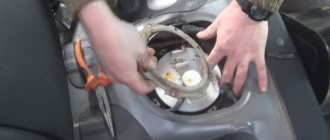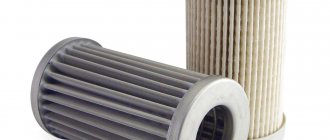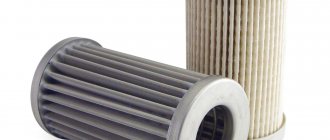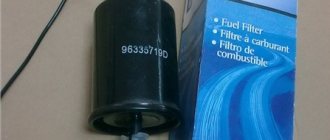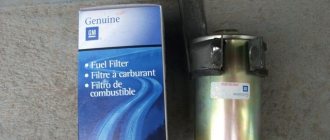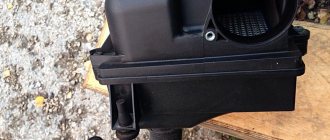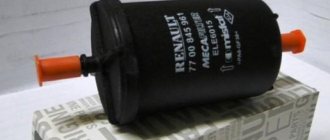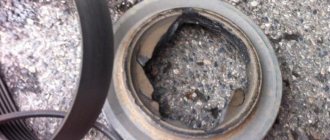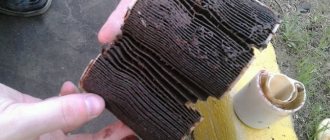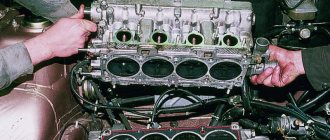The cleanliness and timeliness of oxygen entering the fuel equipment is extremely important to ensure the performance of the vehicle and the power unit as a whole. The completeness of combustion of the fuel mixture determines throttle response, acceleration dynamics, and power indicators. Lack of air leads to depletion of the combustible mixture, engine detonation, and reduced power.
Kia Rio cars are equipped with two fuel filters: coarse filter (mesh filter - a mesh bag) and fine filter (plastic block with a filter element inside). Both filters are components of the fuel module located in the fuel tank.
Technical regulations for replacement
In order to maintain the functionality of the technical product, the manufacturer recommends replacing the Kia Rio fuel filter every 30,000 km. mileage In this case, maintenance is carried out every 15,000 km. In practice, this interval is not maintained. Car enthusiasts who care about their vehicles update cleaning elements every 10,000 km.
The replacement process is not at all complicated; every car owner can do it. Specialists are rarely called to the workshop in case of detection of a large-scale breakdown or other malfunction that requires prompt intervention by a professional.
If you don't change, what will happen?
If the component is not replaced in time, this will put a lot of stress on the pump, which will have difficulty pushing fuel through the system because the fuel pump screen is already clogged. The car will pick up speed worse, the power will decrease and the original dynamics will disappear. Sometimes you may notice a drop in power when the internal combustion engine is running. This is especially noticeable when driving uphill.
The engine will start worse every day, up to complete failure. And this happens sometimes.
Fuel consumption will increase due to problems with the filter. For example, if previously a car consumed 9-10 liters per 100 km, then if the filter is clogged, this figure can increase to 11-12 liters. Drops will appear when you press the accelerator pedal. This can lead to an accident when overtaking on a country road when you need to accelerate sharply.
When you are at a traffic light, the engine idle speed can fluctuate to such an extent that the internal combustion engine freezes up. You will remain standing at the crossroads - this is not very pleasant.
The process of replacing a part on the Rio model is presented in this video:
Reduced fuel pressure Kia Rio
In operating condition, the fuel pressure in the system is significantly higher than atmospheric pressure. To prevent uncontrolled spills of gasoline, all work related to depressurization of the system is carried out with the pressure released. To relieve pressure, first turn off the fuel pump by removing the fuel module power connector or removing the fuse. Then the engine is started and the remaining fuel is exhausted. Without additional actions, the pressure drops on its own 2–3 hours after the ignition is turned off.
To work, you will need a flathead and Phillips screwdriver. The procedure for releasing pressure is as follows.
- Remove (if necessary, pry up with a screwdriver) the plastic cover of the fuse box located to the left of the steering column.
- In operating condition, the fuel pressure in the system is significantly higher than atmospheric pressure. To prevent uncontrolled spills of gasoline, all work related to depressurization of the system is carried out with the pressure released. To relieve pressure, first turn off the fuel pump by removing the fuel module power connector or removing the fuse. Then the engine is started and the remaining fuel is exhausted. Without additional actions, the pressure drops on its own 2–3 hours after the ignition is turned off.
- To work, you will need a flathead and Phillips screwdriver. The procedure for releasing pressure is as follows.
- Remove (if necessary, pry up with a screwdriver) the plastic cover of the fuse box located to the left of the steering column.
- To remove the fuel module (instead of removing the fuse), lift the rear seat and trim flaps underneath, unscrew the mounting screws, remove the hatch cover and disconnect the module's power connector.
- Start the engine and wait for it to stop spontaneously.
- Use the starter to turn the crankshaft several times.
Which filter should you choose?
When choosing a filter element, you must rely on the recommendations of the manufacturer or official dealers. Only an original part can ensure ideal cleaning of the fuel mixture and uninterrupted engine operation.
Not only its service life, but also the degree of fuel purification depends on the quality, and this affects the power of the machine, the behavior of the engine, and the wear rate of its parts. It is a plastic case, inside of which there are 2 filters - coarse and fine, as well as a mesh. You can purchase a suitable element in the online store.
How to replace the fuel filter on a Kia Rio - step-by-step instructions
In order to replace the fuel filter on Kia Rio cars, you must perform the following steps:
- The fuel module is located in the fuel tank located under the rear passenger seat.
- Lift the seat cushion and remove the fastening brackets from the holders.
- Remove the rear seat cushion completely. Under the seat there is an access hatch to the fuel module. To open it, use a knife, because... it is glued with sealant (although self-tapping screws would be quite suitable for fixing it).
- Disconnect the fuel module power supply (ignition must be turned off).
- Using pliers, remove the fuel vapor supply hose to the adsorber. Remove the fuel supply pipe.
- Remove the tube holder from the mount on the fuel module cover. Using a socket wrench 8, unscrew the bolts securing the fuel module cover plate.
- Open the rear doors of the car to ventilate fuel vapors. Remove the fuel module from the fuel tank (be careful not to damage the float).
- Now, to get to the fine and coarse filters, you have to disassemble the fuel module. First remove the fuel level sensor. To do this, disconnect the sensor connector from the module cover.
- Remove the wires from the holders. Use a screwdriver to pry the sensor retainer and slide it down.
- Next, disconnect the fuel pump power plug. Disconnect the tube that supplies fuel to the fine filter. To do this, use a screwdriver to pull out the lock.
- Separate the cover and the fuel module glass. Now you should remove the fine filter with the fuel pump built into it from the glass.
- To remove the fuel pump from the filter housing, press the clamps. Disconnect the fuel coarse filter from the fuel pump.
- When disassembling the fine filter, disconnect the O-ring and the remaining wire. Disconnect the pressure regulator and the remaining fuel drain pipe.
- The fuel filter has been removed. That's it, now you should assemble the fuel module with new filters in reverse order.
Car enthusiasts recommend carrying out preventive maintenance followed by replacement every 10,000 km. In this case, you can count on the longevity of the technical device. Premature replacement of the cleaning element is also justified in the case of systematic filling of the tank by 40 - 60%. The likelihood of sediment formation increases several times.
Possible problems and methods for eliminating them
Unsuccessful repairs often result in problems with starting the internal combustion engine. The car starts after using the starter for 3-5 seconds or does not start at all. As a rule, the reason lies in the o-rings, which are forgotten to be installed during assembly. It happens that the ring does not fit in its usual place, after which it ceases to perform its functions.
For the reasons described, gasoline will return to the tank and the pump will have to pump it again. It is this factor that becomes the culprit for prolonged engine starting. In any case, disassemble the assembly again and install or replace the O-ring.
Sources
- https://remontautomobilya.ru/kak-zamenit-toplivnyj-filtr-na-kia-rio-3.html
- https://to-club.ru/kia/kia-rio/to-obsluzhivanie-kia-rio.html
- https://gyroscooter-izhevsk.ru/transmissiya/toplivnyj-filtr-kia-rio-3.html
- https://kia-bash.ru/kia/zamena-toplivnogo-filtra-kia-rio-3.html
- https://myducato.ru/kia/zamena-toplivnogo-filtra-kia-rio-3.html
- https://rulikoleso.ru/to-kia/zamena-toplivnogo-filtra-v-kia-rio-3
- https://FokSevmash.ru/elektronika/toplivnyj-filtr-kia-rio-3.html
- https://TrueScooters.ru/motor-avto/zamena-toplivnogo-filtra-kia-rio-3.html
- https://FanKia.ru/zamena-toplivnogo-filtra-kia-rio-3/
- https://i-love-mycar.com/kak-pomenjat-toplivnyj-filtr-na-kia-rio-3-tehnologija-i-vybor-luchshego/
- https://r-min.ru/menyaem-toplivnyy-filtr-v-kia-rio-2012-i-2013-poshagovaya/
- https://delis-avto.ru/pro-dvigatel/toplivnyj-filtr-kia.html
DIY replacement process
Replacing the filter device is one of the simplest tasks when repairing a car. To perform it, you don’t have to contact specialists; you can do everything yourself.
Tools and materials
What you will need to replace the part:
- new filter element;
- two screwdrivers - with a Phillips and a flat tip;
- pliers;
- set of wrenches;
- sealed glue;
- stationery knife;
- special product for cleaning carburetors.
User Andrey Totem shot and published a video in which he showed how to replace the fuel filter in a Kia Rio.
Stages of work
How to replace the filter device in Kia Rio cars:
- First, the rear seat in the car is dismantled. To remove the chair, unscrew the screws located between the bottom and top of the seats using a 12mm wrench.
- Lift the lower part of the chair and remove the brackets securing it from the fastenings. Dismantle the pillow.
- In the space under the chair you can see a plastic hatch. This is protection for the fuel pump; it is usually fixed with sealant adhesive. To remove the protection, use a utility knife or a flat-head screwdriver.
- This will give you access to another hatch, which is fixed to the car body with self-tapping screws. The fuel pump is hidden behind it. The hatch screws are unscrewed with a Phillips head screwdriver.
- Before carrying out any dismantling work, relieve the pressure in the fuel line. To do this, start the car engine and disconnect the connector with wires from the plug installed on the pump itself. When the pressure in the fuel system is released, the engine will randomly stall. You won't be able to start it again.
- Before removing the cover, be sure to wipe it with a cloth to remove dirt and prevent it from entering the pump. Otherwise, it will negatively affect its functionality as a whole. If possible, you can use a vacuum cleaner for cleaning.
- Disconnect the fuel supply pipes connected to the device by clamping the fastenings of the lines with pliers. Do not remove the rag too far, as some of the fuel will come out of the hose when removed.
- Use a Phillips screwdriver to unscrew the screws securing the pump device. Move the ring aside and slowly remove the filter part from its seat. When dismantling, be careful not to spill fuel.
- Fix the position of the float used to control the level of gasoline in the system.
- Use a flat-tip screwdriver to pry up the fasteners and disconnect the connected pipes. Disconnect the connectors and move them to the side.
- Carefully remove the retainer from the plastic and release the guides to remove them along with the cover. Now you can remove the part from the so-called glass to clean the fuel.
- Disconnect the ground wire. Use a screwdriver to pry up the ring of the filter element and the latches of the electric motor, and disconnect it.
- Remove the metal valve. Pull the rubber seal out of the filter device.
- Install a new valve into the filter. Loosen the clamps and remove the plastic part along with the seals.
- Install the new filter into the seat. The assembly procedure begins with installing the electric motor on a new filter device and fixing the fastenings of the fuel lines.
- The new filter is mounted in the fuel pump glass. The hatch is installed in place and secured with screws. The connector with wiring is connected. The protective plastic cover under the rear seat of the car is treated around the perimeter with airtight glue and mounted in place.
A Hyundai Solaris / Kia Rio user presented a video that describes in detail instructions for changing the fuel cleaning device.
Price issue
The cost of an original filter for cleaning fuel in a Kia Rio is about 1000-1500 rubles on average. To save money, you can buy an analogue, its price varies around 400-800 rubles.
Summary
All components and mechanisms of a car are considered important units, but there are some that are especially significant. If one of these systems is broken, then the car simply won’t go anywhere. These include fuel, because if fuel does not enter the combustion chambers, then the car will not be able to move.
There are several reasons, but the most common on cars with sufficient mileage is that the fuel filters become clogged. Each car has two or three filter devices; on more expensive cars, of course, there are more, but in any case, parts need to be changed with particular frequency. Otherwise, the car will absorb more fuel, but lose power.
Reasons for lack of fuel in the engine
A common and simple reason is that the tank has run out of fuel. The indicator does not correctly display the amount of fluid in the tank, and it will run out unexpectedly while driving.
A clogged injection system is considered the next reason. Injectors and fuel mixture filtration parts purify gasoline before it enters the mechanism. Otherwise, the channels become clogged and fluid does not flow.
Pay attention to the thickness of the channels, because they are very thin and clog with any debris. Therefore, the developers came up with three types of fuel filters.
How to replace this consumable yourself
If you have an idea and will do it yourself to replace the fuel filter, this will allow you to save on service costs. In this article we will tell you how to change the filter, as well as where it is located, but before you start, you will need to purchase a new consumable, for this you only need to know its catalog number.
To successfully implement the process you will need to use the following tool:
- screwdrivers with slotted and Phillips profiles;
- keys and pliers.
Have you decided to seek the help of experts? For this procedure you can fork out 1.5 thousand rubles. taking into account the price of the part. Even if it is under warranty service, your Kia Rio 3 cannot count on replacing the filter without payment, since this element is positioned as a part subject to natural wear and tear. This also applies to brake pads and discs, lamps, fuses, etc.
Consequence: some Kia Rio 3 owners tend to refuse warranty service a year after the start of operation.

